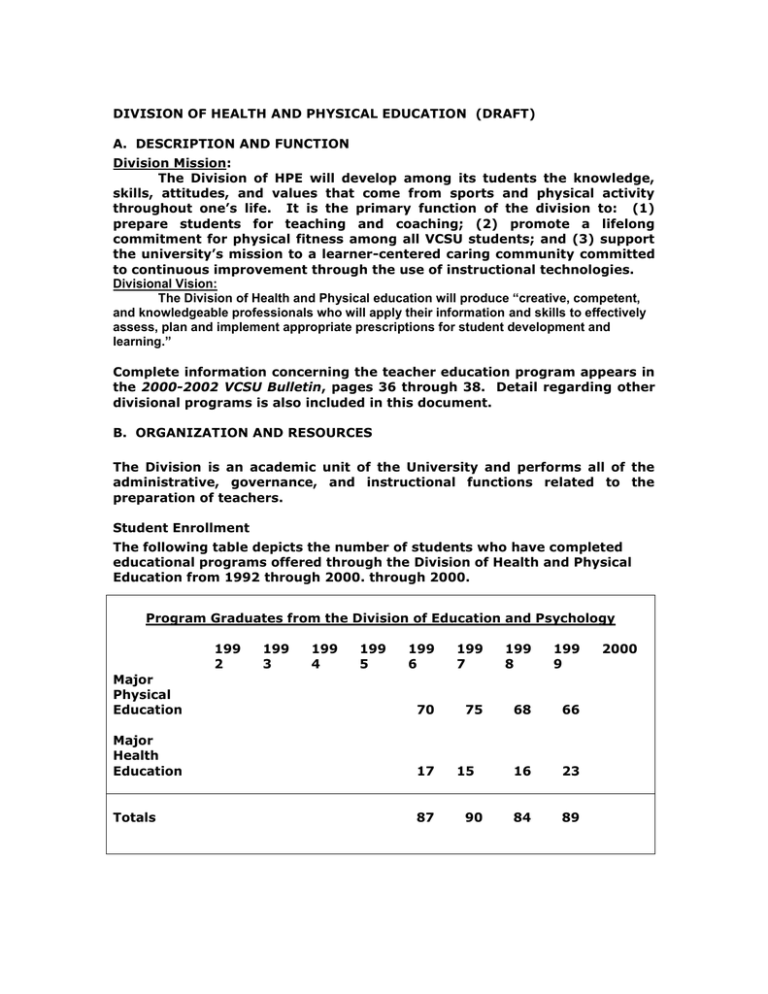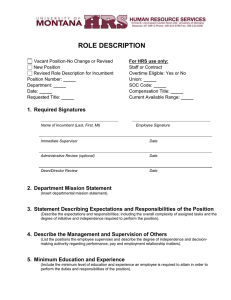HPE NCA Narrative.doc
advertisement

DIVISION OF HEALTH AND PHYSICAL EDUCATION (DRAFT) A. DESCRIPTION AND FUNCTION Division Mission: The Division of HPE will develop among its tudents the knowledge, skills, attitudes, and values that come from sports and physical activity throughout one’s life. It is the primary function of the division to: (1) prepare students for teaching and coaching; (2) promote a lifelong commitment for physical fitness among all VCSU students; and (3) support the university’s mission to a learner-centered caring community committed to continuous improvement through the use of instructional technologies. Divisional Vision: The Division of Health and Physical education will produce “creative, competent, and knowledgeable professionals who will apply their information and skills to effectively assess, plan and implement appropriate prescriptions for student development and learning.” Complete information concerning the teacher education program appears in the 2000-2002 VCSU Bulletin, pages 36 through 38. Detail regarding other divisional programs is also included in this document. B. ORGANIZATION AND RESOURCES The Division is an academic unit of the University and performs all of the administrative, governance, and instructional functions related to the preparation of teachers. Student Enrollment The following table depicts the number of students who have completed educational programs offered through the Division of Health and Physical Education from 1992 through 2000. through 2000. Program Graduates from the Division of Education and Psychology 199 2 199 3 199 4 199 5 199 6 199 7 199 8 199 9 Major Physical Education 70 75 68 66 Major Health Education 17 16 23 Totals 87 84 89 15 90 2000 Program Graduates from the Division of Education and Psychology 199 2 199 6 199 7 199 8 199 9 Minor Physical Education 23 22 23 22 Minor Health Education 6 9 12 Minor Coaching 199 3 199 4 199 5 9 105 92 94 86 1 2 4 4 130 114 2000 Minor Recreation Totals 125 145 Faculty The Division of Health and Physical Education has eight full-time faculty members. All members have a masters degree. There are four adjunct faculty. One member has an earned doctorate As reflected in individual faculty data sheets, divisional faculty are involved in numerous professional activities. They are successful teachers, coaches, and administrators. The academic ranks of the divisional faculty consist of four Associate Professors, one Assistant Professor, three Instructors, and one Lecturer. Three full-time faculty members are female and five are male. The unit faculty members teach a load of twelve semester credits. One teacher supervises student teachers and also has administrative responsibilities that are reflected in individual teaching loads. Six faculty members have coaching responsibilities, one is the Intramural Director, and one is the division chair. Support Staff One full time assistant and one half time assistant, along with three student workers, serves the Division of Health and Physical Education. The full time assistant provides clerical service, supervises student work hours, supports both full and part time faculty members, and contributes to the general welfare of the unit in a variety of other ways. The assistant also serves the entire athletic program and the half time athletic director. Facilities and Equipment The unit receives a reasonable proportion of the VCSU budget to accomplish its purposes, and Library resources are adequate for its programs. The chart that follows provides dollar amounts for the instructional budget from 1997 through 2001. Division of Health & Physical Education Budget Compared with the Total Instructional Budget, 1997 – 2001 1997 1998 1999 2000 2001 Salaries and Wages Health & Physical Ed. Total Instructional Budget Operating Health & Physical Ed. Total Instructional Budget Equipment Health & Physical Ed. Total Instructional Budget Totals Health & Physical Ed. Total Instructional Budget Although it has allocated some equipment expenditures to the division over the past five years, VCSU has not formally provided an equipment budget to any unit since 1995. The anticipated inception of the notebook computer initiative necessitated that move. C. ASSESSMENT While the entire campus community is credited for the commendable NCATE review, the unit faculty members and teacher education students played a critical leadership role and they continue to exert their influence as key players in the transformation of teaching and learning. Adoption of the Abilities Model. Clinical and field-based experiences with review by student, cooperating instructor, and faculty mentor. Student portfolio development. Continuous student evaluation of course objectives. First and third year teacher education graduates complete the HPE Alumni Survey to determine the degree of satisfaction related to preparation. Digital portfolios as an exit requirement. Divisional improvement plan. Assessment of student success takes place from entry to exit: General Education courses are linked to the abilities. Major courses track abilities to higher levels. Portfolio development documents abilities. Successful completion of field experiences. Departmental expectations of students are high: The VCSU Health & Physical Education graduate will be able to demonstrate: a.) higher order thinking skills and the application of critical thinking skills the ability to effectively communicate (i.e., written, verbal, presentation, etc.) b.) concrete application of content knowledge c.) the ability to access relevant information d.) the ability to work cooperatively e.) the appropriate use of technology Is this linked to the abilities? The divisional abilities of Communication, Problem-solving, Wellness, and Technology are four of the eight university Abilities (see appendices). Students must complete the fourth level of five of the eight Abilities in order to satisfy the graduation requirement. The fifth ability is the student’s choice, probably from his/her second major or the academic minor(s). Have you built in systems for change based on what you know? What are they? The HPE Assessment Plan, continued use of alumni surveys (every other year), course assessments, senior exit interviews, and the quality of the HPER students’ digitized portfolio will provide feedback. This program review, with feedback from the outside evaluator and the VCSU VPAA, will provide us with valuable advice on the effectiveness of the curriculum and instruction. Curricular/program changes could then be proposed for the next bulletin (catalog) for 2002-2004. Surveys: One and three year (program) graduate surveys have been administered in the following summers: 1996, 1998, & 2000 (see report in appendices by Dennis). Is there other data? Course assessments: spring, 1999, and fall and spring, 2000; senior exit interview questions (interview results spring, 2000). 1999-2000 Baseline Program Goals: Baseline Program Goals: originally defined as Divisional Goals-1998 This section now establishes the link between the University mission and the Division of HPE. The Division of Health and Physical Education will develop preprofessional students through active integration of its divisional and the University’s mission and vision statements. This integration is demonstrated by the dovetailing of the University Abilities and the Divisional Baseline Program Goals. The purpose of the HPE Baseline Goals are to help foster the development of the foundational skills that are necessary to the development of the “total professional” in the discipline(s) of Health, Physical Education, Recreation, and Dance. The Division builds systems for change through the following: Through assessment and reflection, abilities and portfolios continue to evolve. Definitions and rubrics for abilities and skills reflect University program objectives. Field site visitations identify skills of effective teachers in today’s changing classrooms. Exit information regarding new teachers is gathered through: Surveys of first year teachers conducted by the chair of the HPER division. Surveys of administrators who have hired VCSU first year teachers conducted by the VCSU Career Planning and Placement Office. Strengths Valley City State University has positioned itself in a leadership role in the application of information technology to the teaching-learning process. The Division of HPER is substantially invested in this mission and is actively involved with and supportive of these campus initiatives. The division completed an extensive program review in the spring, summer, and fall of 2000. The steps of this process and the results are explained elsewhere in this document. The HPE course syllabi support both the division’s and the university’s mission statements. The division utilized a course assessment instrument to confirm the faculty’s use of the division’s and university’s goals. The course assessments confirm that the faculty’s teaching strategies are following the division’s goals. Those strategies are reflective of learner-centeredness, student responsibility, and reflection for the purpose of self-evaluation and continuous improvement. The division’s upper level methods course provides clinical experiences in the public school setting. The division also supervises most of its Health and Physical Education majors. Confirmation of the supervisor’s work is on record in the education department’s office. All of these programs which prepare middle and secondary teachers have been reviewed by the North Dakota Professional Standards and Practices Board and found to be in compliance with standards. The admissions criteria are published, generally understood, and rigorously administered during the admissions process. All faculty have teaching assignments appropriate to their training and experience. This (notebook computer) initiative certainly qualifies as one of the strengths of the unit and of the university and the unit deserves much of the credit for its leadership in this technological innovation. The library resources provide adequate breadth, currency and perspectives. Facilities are functional and well-maintained. Concerns Student request for earlier and longer practicum experiences. Difficult with only one junior/senior high school that is already accepting our student teachers. Updating the curriculum. Several meetings have take place over the fall semester by the HPE Curriculum Committee and the entire HPE faculty. The following items were utilized during the meetings: the (present) student survey (HPE majors/minors and coaching minors #60); the past two alumni survey results (1996 & 1998: 2000 recently sent); and the final report of the outside evaluator from our spring/summer program review. Additional items needed for entry and exit assessments. Dual responsibilities of the coaches and instructors. D. Plan for the Future Paralleling the VCSU strategic plan, the proposed HPER curriculum revisions, the abilities project, and the most recent alumni survey serve as guides for future developments. Individual faculty members engage in professional activity that supports the plan. Division of Health and Physical Education Focus: To advance the university mission and vision by supporting the strategic plan and by building on the belief that competent teachers are knowledge based decision makers. Goals and Strategies for Achieving the aforementioned focus: The HPER Division attempts to provide opportunities for students to maximize their learning for a lifetime by requiring digitized portfolios. See the division’s mapping of abilities to see where and how it’s faculty provide technological learning opportunities to its majors and minors. The division’s faculty has adopted the notebook initiative into its course outlines. The division supports the Abilities model (see the specific abilities listed in another part of this report). Each faculty member updated its course outlines in the summer of 1998 to reflect the adoption of its division’s new objectives. One faculty member moved one of his classes to an on-line course in the fall of 2000. Other faculty have attended workshops on Blackboard during the spring, summer, and fall of 2000. In the fall of 1999 one faculty member made a presentation at the NDAHPERD state workshop about the notebook initiative and its students’ work on the CD-Rom portfolio. Concluding their programs of study, students complete digitized professional portfolios that document their learning and accomplishments during their time at Valley City State University. Graduates leave as wellqualified candidates for service in their respective professions. E. DOCUMENTATION Valley City State University 2000-2002 Bulletin North Dakota State Program Standards Graduate survey results Course evaluations Course Outlines and Course Syllabi


